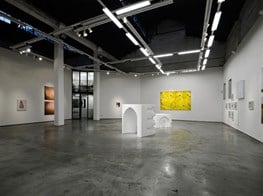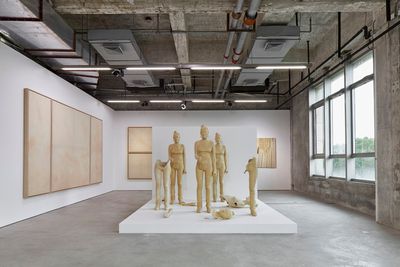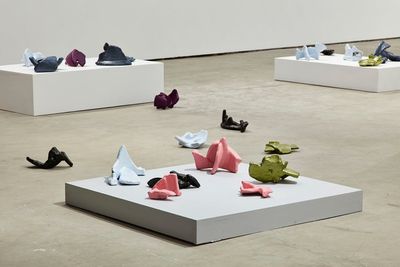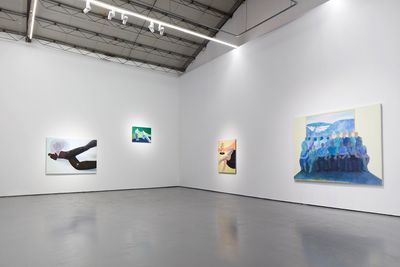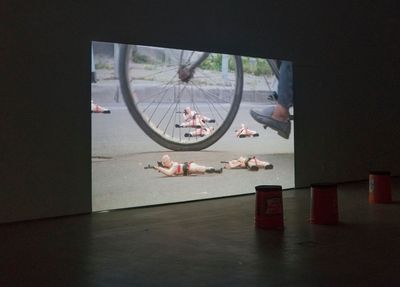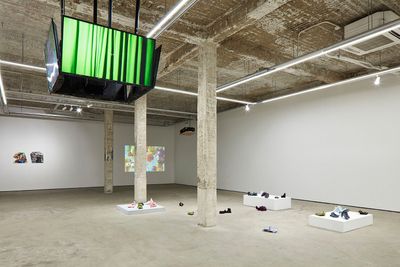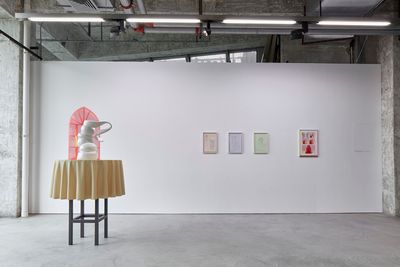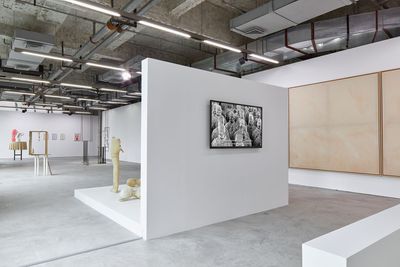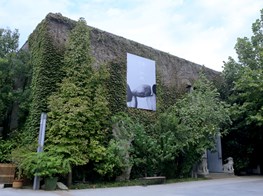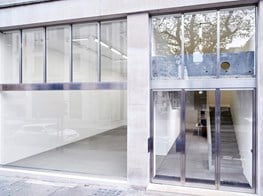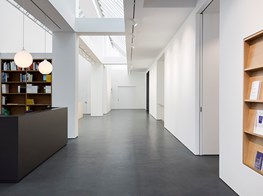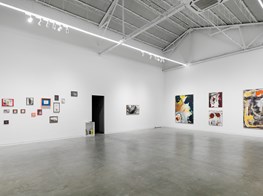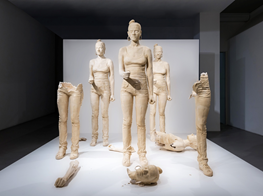Lorraine Kiang Malingue
Lorraine Kiang Malingue. Courtesy Edouard Malingue Gallery.
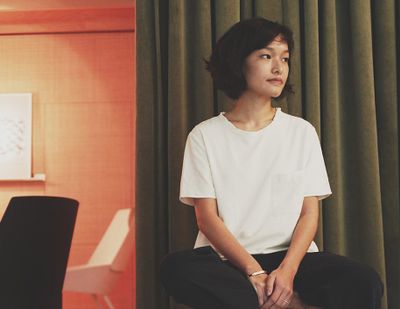
Lorraine Kiang Malingue. Courtesy Edouard Malingue Gallery.
Condo Shanghai (7 July–26 August 2018) is the first Shanghai edition of the Condo project, which was initiated in London in 2016 by gallerist Vanessa Carlos, of Carlos/Ishikawa. Since its inception, Condo has toured to cities like São Paulo (2018), Mexico City (2018), and New York (2017 and 2018). It connects local and international galleries by turning local galleries into host spaces for galleries participating from abroad, with exhibitions that showcase their programmes. The model is considered an alternative to art fairs at a time when galleries and global audiences have become somewhat exhausted or overstretched by the global rise and expansion of the fair circuit. Over the years, participating galleries have included Project Native Informant, Rodeo, ShanghArt, greengrassi, Maureen Paley, Sadie Coles HQ, Galeria Jaqueline Martins, Pilar Corrias, König Galerie, and many more.
The first edition of Condo Shanghai involved 22 local and international galleries, from established international galleries like Esther Schipper and MadeIn Gallery, to young local spaces such as J: Gallery and Gallery Vacancy. As is the custom, one participating local gallery acts as the organiser and liaison between all participants; for Shanghai, Edouard Malingue Gallery, which brought the project to the city, has taken the role.
After the opening of Condo Shanghai across the West Bund, French Concession and M50 district, Lorraine Kiang Malingue, co-founder of Edouard Malingue Gallery, spoke to Ocula about the inception of Condo Shanghai, and her work with Edouard Malingue Gallery.
LBWhat gave you the idea to bring Condo to China?
LKMI had a conversation with Vanessa Carlos a year ago, and we were put in touch because she was trying to see if I would be interested in helping to organise Condo in Asia. We talked, and she was very open-minded. Between Hong Kong and Shanghai, I prefer Shanghai, because there are many more local galleries that we can work with; and thought that Condo would be a very good opportunity for Shanghai to gain more momentum. So I suggested Shanghai and that's how we got it going.
Basically, each Condo city is managed by different galleries, so [Carlos] is totally uninvolved with Condo New York, Condo Mexico, or Condo Shanghai. Whoever is organising a given project has the say on how it's defined, who's invited, and how the project is shown. I was looking to work with galleries in Shanghai, large and small, that support young artists, and are more or less located in a certain geographical area. It usually works best when galleries are somewhat clustered together, and visitors can go from one gallery to the other easily. Most spaces participating this year are in the West Bund, with a couple in the M50 district, and one in the French Concession.
When I proposed the project, a lot of galleries were very supportive, so it wasn't hard to finalise the participating list of galleries in Shanghai. Eventually, we came down to nine that were available to show during the summer time slot that I suggested, since this is a less busy time for galleries. When it comes to the foreign galleries, both young and established, some have participated in Condo projects before and others are new to it. It's nice to have a mix, I think. For the Shanghai or Chinese audience, I think it's important for them to be familiarised with young galleries, but also a couple of more established ones to give them the right idea as to what Condo could be about, and the diversity of artists that could be shown. Even the established galleries who have joined Condo are showing the younger artists in their programmes.
LBCondo is described as a response or an alternative to the art fair, which allows galleries to collaborate with one another on a lower budget and in greater depth. But who makes the final decisions when it comes to organising an event like this?
LKMI don't think it's so much an opposition to art fairs; it's just an alternative option to ways of collaboration between galleries. It's always nice to have different options when it comes to ways of collaborating.
I am mostly the person who matches the galleries together, because a lot of the Shanghai galleries have never collaborated with a foreign gallery. For them, it's a new thing, but it's something they're also very keen on. I was happy to put them in touch, and let them discuss what they would like to do together. But I was not instrumental in the programming of any of the shows. It was more like a group date scenario: they go to whoever they find interesting and talk about it in detail. You fix the time together, confirm the general idea, and talk about the specificities. I encourage the collaborative element, so that each gallery that is hosting is also showing with the visiting gallery. For me, this is much more interesting, because there's a dialogue between the artists.
LBWhat do you think Condo Shanghai might mean for foreign galleries? It is a way to test the waters of the Asian market, surely?
LKMIt's extremely low cost for them to participate, and as you say, to test the waters of the market in Asia, and expose their artists in Shanghai for the first time. I think it's about galleries doing the groundwork for their artists in an alternative and very creative way. The spirit of Condo is also very positive; a lot of galleries are happy to do it. I think it's very timely as well. My impression is that, in general, people are rather fed up with the countless art fairs everywhere in the world that are extremely expensive for galleries to participate in, with possibly very little outcome.
LBWhat were the difficulties in organising Condo Shanghai?
LKMThere could always be more galleries participating. But for the first edition, I was cautious to not pick too many areas in Shanghai, hoping that the galleries could be close to one another. There are also galleries that are somewhat afraid of inviting foreign galleries because it means increasing the exposure of Western art to the Chinese market, maybe fearing competition. I think that fear is natural, but I also think the increase in exposure is inevitable. We are working in a global city; collectors travel everywhere, so it's inevitable to become open and exposed to artists from everywhere. It's much better to welcome this than to avoid it.
LBAnd be prepared for it.
LKMExactly. I think that exposure and diversity strengthen the art scene much more. We're not talking about just a regional scene. By inviting galleries abroad to come, I think it makes Shanghai much more global.
LBWill Condo Shanghai become an annual event?
LKMI'm hoping to do it again next summer. I think more galleries would be happy to join. Since it's the first edition, some galleries were not sure, and they wanted to see how it turned out. I think the main thing is that I just let the galleries do their own thing, so each gallery feels responsible. One main issue this time was that foreign galleries were not necessarily familiar with China and its infrastructures.
LBWould you consider including non-profit organisations?
LKMI think it makes sense to work with non-profits if they're happy to lend their spaces.
LBEdouard Malingue Gallery has gained substantial influence in the Chinese contemporary art world, especially since it opened its Shanghai space in November 2016. How would you introduce the history of the gallery?
LKMWe started the gallery in 2010 in Hong Kong, and we opened the space in Shanghai almost two years ago. One of the gallery's focuses is to support young, emerging artists. Our artists range from those who are in their thirties to the oldest artist of ours, who is in his eighties; and other artists to be rediscovered. We are really interested in connecting artists from the Asian region with the West. Currently, we work with 23 artists, and half of the programme is made up of Asian artists. We're very keen on that kind of support, especially being based in Hong Kong, which is a very global city; we really want to have a platform that is both international and local.
The Hong Kong artists we work with include Wong Ping, Samson Young, Kwan Sheung Chi, Ko Sin Tung, and João Vasco Paiva who is living in Hong Kong. In Taiwan, we work with Chou Yu-Cheng; and in China we now work with quite a few artists. It's nice to be working with artists from the region. We are very active in developing their careers and exposing their works to the West. We also do a lot of collaborations with curators outside of the gallery.
Personally, I have a strong interest in video art.
LBHence, Wong Ping, Sun Xun and João Vasco Paiva, among others?
LKMYes, we work with quite a few video artists and since last summer we have been actively promoting film and video. Last summer we did film screenings at the gallery, and will do so again this summer. We also did one screening programme in Manchester last year: a pop-up of a three-day screening programme of works by artists we both work with and don't. The idea was to show video artists from Asia to a UK audience.
LBHow strategic is the gallery's programming when it comes to local, Asian artists making up half of its programming?
LKMI think there is a lack of galleries based in Asia who are interested in showing the public what Asian artists from this region are doing. I think there's much more to be shown globally for these artists. There is a huge lack of galleries supporting artists from the rest of Asia in Shanghai or in the mainland in general, which is why we are so keen on promoting artists who are not just from mainland China, but from all over Asia. We have recently also started working with Ho Tzu Nyen from Singapore to stage his first solo show in China, One or Several Works at Ming Contemporary Art Museum [6 July–9 September 2018]. He's one of the artists that I find so outstanding in Asia but has very little exposure outside of Singapore. For us it really makes sense to show him here in Shanghai. I think his works are most suited to institutions, which is why we were able to find a place for the project within the Ming Contemporary Art Museum in Shanghai.
Aside from Ho, we also work with Tromarama from Indonesia. They are young art collective also working in animation and video installations. They showed at the Gwangju Biennale in 2016, and they are going to have a couple of commissions in Australia, where there's been a strong interest in Indonesian art. There's also Chou Yu-Cheng from Taiwan, who we showed last November in Shanghai as an attempt to expose his works in Mainland China. Chou's practice has been very, very well received. It's extremely conceptual for the Asian market, but his language is so unique—very refined. So eventually it worked very well.
LBWhat would you identify as the major difficulties that the gallery has faced since it started?
LKMI think every gallery has to have a certain identity. For us, that identity is rooted in Asia—Hong Kong is our base. I think that really defines how we carry the programme, which is very different from foreign galleries opening a space in Hong Kong. They have a very different agenda compared to us.
LBDo you consider this a home instead of an outpost?
LKMYes. And I think because Hong Kong is such a central city in Asia, our programme extends beyond the city itself.
In Hong Kong, it's extremely difficult to be a gallery because of the high rental cost. But so far we have worked with artists who have become more and more successful along the way. Thanks to that, we are still surviving. Along the way, I think the programme has strengthened a lot in terms of depth, artist selection, and the scope of works that we are showing. It's certainly not the most commercial programme. I think that is essentially what is needed in this region.
We are very happy just being in Shanghai and Hong Kong for the moment, but we are not tied here; we can do projects anywhere. In fact, we will be doing a project with a non-profit space in Beijing soon.
LBAnd you take pride growing with artists?
LKMYes. I mean it's obvious that many of them have a lot of room for growth. They are being pushed in the right direction. It really shows that there is a huge capacity for artists from this region to develop themselves with the right opportunity and with the right support. I certainly feel that with some of the artists that we show, even if they are more conceptual, they can be on par with artists from the West who are on the same career paths. It's just a matter of time before the West will be looking towards Asia. We're just doing the groundwork.
In terms of the number of collectors based here, we're talking about a much smaller number, compared to Europe or the US. It's no match; which is why there's a lot of reaching out for us to do as a gallery. We can't just rely on collectors based in China. We work with collectors all around Asia and some in Europe and Australia. It's a broad range, but hopefully that will also slowly increase over time.
LBDo you have a rough percentage of how many Chinese collectors have been supporting young, emerging artists from the region in recent years?
LKMAround 20 percent. —[O]


